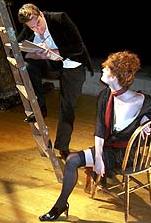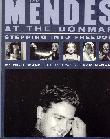SEARCH CurtainUp
REVIEWS
FEATURES
NEWS
Etcetera and
Short Term Listings
LISTINGS
Broadway
Off-Broadway
BOOKS and CDs
OTHER PLACES
Berkshires
London
LA/San Diego
Philadelphia
Elsewhere
QUOTES
On TKTS
LETTERS TO EDITOR
FILM
LINKS
MISCELANEOUS
Free Updates
Masthead
NYC Weather
Tatjana in Color: The Trial of Egon Schiele
|
I do not feel punished; rather purified. To restrict the artist is a crime. It is to murder germinating life.---Egon Schiele, defiantly painting himself as a victim after his conviction for corrupting the morals of a minor.
|

Glenn Fitzgerald & Rebecca Wisocky
(Photo: R. Lasko) |
With Rebecca Wisocky, an accomplished dancer as well as actor, listed as a member of the cast and given the show's venue, which is often home to artful productions, it seemed reasonable to anticipate atmospheric music and dancing to augment the play. To make Tatjana even more intriguing, it is one of four plays being produced in one year with Julia Jordan's by-line -- -- one of which, St. Scarlet (see link), sufficiently impressed my colleague Les Gutman to conclude "She reveals enough ideas here to make us eager to see what more she has up her sleeve."
Tatjana, does indeed showcase a fertile playwriting mind at work. Yet, even though director Will Pomerantz has done his utmost to make the somewhat cavernous basement space and obviously minimal design budget work to the the advantage of the story and the actors, neither the play or the production are as satisfying as I had hoped they would be. The staging is a bit too self-consciously arty and the authorial melding of fact and fiction, while interesting, has its title character and her sister Antonia at times coming off as runaways from one of Ms. Jordan's popular adaptations for the children's theater company, Theaterworks/USA.
Ms. Jordan certainly had an intriguing idea up her sleeve when she decided to dramatize the events surrounding the real 1912 trial of Egon Schiele for corrupting the morals of a twelve-year-old girl, by making that girl, Tatjana von Mossig, her play's pivotal character. While Schiele and his model and mistress, Wally Neuzill (also based on an actual person), are crucial to the aura and details of the plot, they are trigger characters. What Ms. Jordan is after is their effect on the rebellious, impressionable, hormonally charged pre-teen.
Schiele's studio in the town of Neulengbach, Austria, some twenty miles from Vienna, was actually something of a hangout for a number of the pubescent girls who willingly posed for his Freud-influenced, psychologically probing paintings. I have no quarrel with the authorial focus on the precocious Tatjana. The girl's attempts to replicate the painter-model experience she observes and becomes part of in the studio by using her younger sister Antonia smartly underscores how being with Egon and Wally fires up not just her sexuality but her ambition to become more than a dull Austrian hausfrau.
Since Austrians have a well known love affair with fine pastries and strong coffee it's also not unreasonable to believe that the availability of both in Schiele's studio would be as much a magnet for a young girl whose strict father keeps her on limited sweet rations then the mysteries of art and sex. But add to the considerable fuss about pastries, a much made of business with the younger sister's pet mouse, and you're headed straight for the already mentioned problem of the clash between adult and young adult genre. The problem is in many ways one of the play's strengths since Ms. Jordan has a wonderful feel for characterizing young people which is evident in both Tatjana and her sister. The scene that introduces young Antonia as a witness at Schiele's second act trial for corrupting her sister's moral, is quite funny, but it comes off funny as in a kids' story funny rather than absurdist adult play funny.
Kate Wetherhead, who has appeared in both of Jordan's plays for young people (Sarah, Plain and Tall and Summer of the Swans) is an engaging Tatjana. Nicole Lowrance is an adorably petulant Antonia who almost makes you believe she's only ten. Both metamorphose convincingly into young adults in the final scene, with Antonia not only still insistently following her older sister around, but taking a step forward from tagalong to leader.
As subtly shaded as any painting is Rebecca Wisocky's characterization of Wally, the free-spirited sensual and loyal mistress-model who is also something of a mother figure for Tatjana. At the time the play unfolds (1912), the real Wally was actually just twenty-two, the same age as Schiele. Making her a woman in her thirties is a smart move since it adds to her allure and mystery. As I had hoped, Ms. Wisocky does get a chance to display her prowess as a dancer in a stunningly stylized scene in which her striking studio poses are seen in a more stylized format against an upstage screen. Too bad this is just one brief scene out of a total of twenty-four. The play is also enhanced by the pulsating musical accompaniment, though it could stand a little downplaying.

One of Schiele's nudes
|
A fifth cast member, Brad Bellamy, handily assumes the roles of Tatjana's father, the judge at the trial and the girls' sarcastic school teacher. For the latter role set designer Troy Hourie has cleverly created a schoolroom at the side of the stage. True to the surname, Devon Painter, has created some splendidly painterly costumes -- with the ones for Ms. Wisocky often looking as if they were lifted right from a Schiele canvas.
It's interesting to note that while the play ends with Wally being a case of no good deed (like her loyalty to Schiele in his time of trouble) goes unpunished. Schiele casts her aside for another model whom he married. The real back story to this is that Wally became a World War I nurse, that Schiele was called up and survived -- only to succumb, at just twenty-eight, to the fever that killed his pregnant wife.
Ms. Jordan has brought a good deal of imagination to this story of a painter whose eroticism on canvas continues to make a strong impression even in an age where sex a widely available commodity in the media. She obviously has a special touch for bringing young people to life, even though this proves to be a mixed blessing in this play. Since Tatjana In Color was actually written eight years ago and there's nothing in the program to indicate that this production represents a major rewrite, the stories about her having four "new" plays produced in one year are somewhat less than accurate -- which. leaves me eager to see the next really new play she's got up her sleeve.
LINKS TO REVIEWS OF PLAYS MENTIONED
Vienna Lusthaus
St. Scarlet
|
Tatjana in Color: The Trial of Egon Schiele
Written by Julia Jordan Directed by Will Pomerantz Cast: Brad Bellamy, Glenn Fitzgerald, Nicole Lowrance, Kate Wetherhead, and Rebecca Wisocky. Set Design:Troy Hourie Costume Design: Devon Painter Lighting Design: Joel Moritz Sound Design: Will Pomerantz Running time: 2 hours and 20 minutes, includes one intermission The Culture Project @ Bleeker Street (downstairs) 45 Bleecker Street , 212-307-4100 Getting there: 6 train to Bleecker St.. . . F, V train to Broadway/Lafayette, and walk one block north to Bleecker St.. . . N, R train to 8th St., and walk south to Bleecker St., and one block east to Lafayette; or to Prince St, and walk north to Bleecker St. and one block east to Lafayette. From 10/25/03 -- Final performance 11/30/03 Monday, Wednesday - Friday @ 8pm, Saturday @ 4pm & 9pm, Sunday @ 7pm-- $35. Reviewed by Elyse Sommer based on October 27th press performance |

Mendes at the Donmar
Our Review

At This Theater

Leonard Maltin's 2003 Movie and Video Guide

Ridiculous!The Theatrical Life & Times of Charles Ludlam

Somewhere For Me, a Biography of Richard Rodgers

The New York Times Book of Broadway: On the Aisle for the Unforgettable Plays of the Last Century

6, 500 Comparative Phrases including 800 Shakespearean Metaphors by CurtainUp's editor.
Click image to buy.
Go here for details and larger image.



